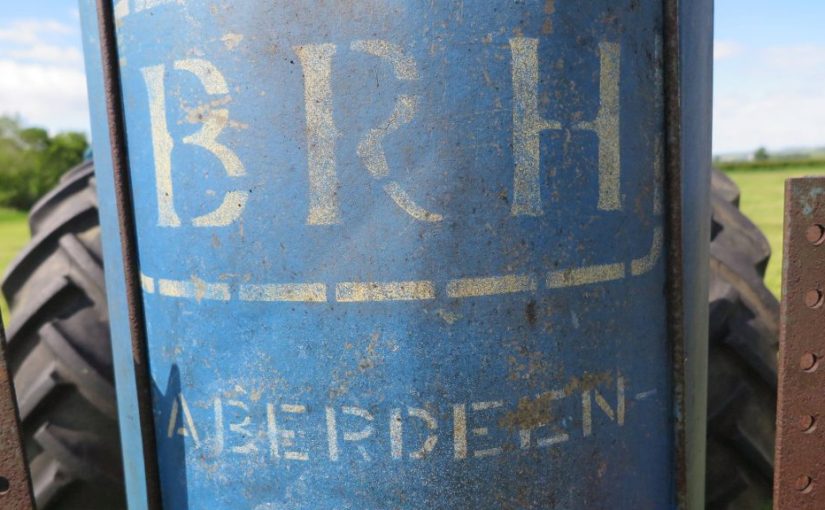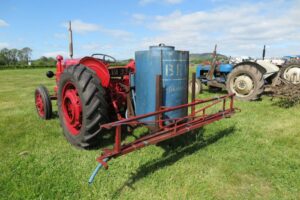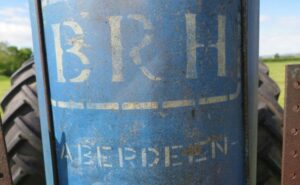Readers of this blog will be aware that we have sometimes referred to the eminent business of Barclay, Ross and Hutchison. We’ve recently found an article in the Aberdeen press and journal of 25 May 1971 which sets out some of the history of the business. It is quoted at length:
“Saga of Barclay, Ross and Hutchison Ltd – turnover £ 1 1/4m
“Trade increases the wealth and glory of a country; but its real strength and stamina are to be looked for among the cultivators of the land.”-Lord Chatham
Gratifying words for farmers. And this quote might well have been the creed of Morrison Barclay, an Aberdeen businessman who was founder of Barclay, Ross and Hutchison Ltd. It was in 1871 that he opened a shop in Russell Street to cater for the needs of farmers.
His venture embarked on its first expansion at the turn of the century when Mr Robert R. Ross, a seedsman, and Mr Robert Tough, who had experience in agricultural commodities and machinery, joined the founder.
Expansion
Now established in Carmlite Lane, adjoining Corn Market and Joint Station, trading was expanded to include all types of agricultural machinery and farm seeds. Soon the trade winds were blowing for the city firm and in 1900 the present head office and main warehouse of the company. Balmoral buildings, 67-71 The Green were acquired.
A few years later, in 1903, Craigshaw Works were purchased. The firm were planting seeds in addition to selling them! And they were taking toot in fertile ground.
Craigshaw Works soon “boasted” their potential.
Down memories lane …
The first machine to take shape was a BRH threshing mill – a prototype for several thousands in the North – until replaced by the combine harvester. The last threshing machine to be assembled at Cragshaw was in 1953.
In 1936 this production unit achieved the distinction of turning out the first powered spraying machine in the UK. Some four years previously Craigshaw Works produced one that was horse-drawn.
In 1912 came the advent of Thomas Hutchison. He had been associated with farm supply through a cart-wright’s business at Peterhead which built the noted Simpson cart. Mr Hutchison became a director of the Aberdeen firm in 1919, the year in which they were registered as a limited company under their present name.
Barclay, Ross and Hutchison became a subsidiary of Scottish Agricultural Industries in 1929. But they retained their name, independent status and management – “home rule”! while functioning within the SAI group, branches were acquired at Perth, Forfar, Montrose and Turriff, thus considerably extending the trading area which was originally confined to Aberdeenshire and Kincardineshire.
“New firm”
SAI withdrew from the agricultural machinery business in 1957, the branches at Perth and Forfar were sold separately and an independent private company, headed by the senior management and staff, was formed to take over the premises at 67 The Green and Craigshaw Works, Aberdeen, 39 High Street, Montrose, and Schoolhill, Turriff. The new firm retained the name “Barclay, Ross and Hutchison Ltd.”
Since the mid-50’s their horticultural department has been considerably expanded and by the 70’s BRH were claiming to be the largest suppliers of garden tools, equipment, implements, machines, seeds, weed killers and sprays in the North of Scotland.
The “centenarian” firm are also in the lead in grass seed drilling. This method of pasture-making obviates several of the disadvantages of the old broadcast and harrow-in practice. Grass seed rollers with seed boxes, grain-graders and cleaners, potato graders, turnip cutters, seed conveyors, elevators and bins-and the entire range of grain handling equipment which followed in the wake of the combine harvester-are included in their range of sales.
The dairy farmer can have cow cubicles, conveyor systems for automatic feeding and similar equipment. All branches of farming are catered for. Plans and advice on new farm buildings and installations are frequently sought are soon forthcoming.
Four counties
The operational area by this time included four counties-Aberdeen, Banff, Kincardine and Angus. Later Moray was added. The “vintage” agricultural engineering business of Charles Taggart & Co., in Ashgrove Road, Kittybrewster, was acquired in 1969.
A strategic move this, for with the “fade out: of the farmers rendezvous in the Corn Market, Kittybrewster became their hub – with Barclay, Ross and Hutchison ideally located to cater for their requirements.
The consolidation phase continued during the early 60’s. Trading was further expanded in all types of agricultural and horticultural machinery, farm seeds and ironmongery. A repair work-shop had been built in Cornfield Road, Turriff, a millwright show completed at Cragshaw Works, a work-shop and implement store at Montrose and an additional branch opened at West End Garage, Huntly.
Farm seeds – one of BRH’s early activities and still a speciality – and grasses and clovers are bought from growers at home and abroad for blending into mixtures suitable for North-east soils and climate. A large volume of business is done in roots – swedes and turnips.
These are grown in special contract seed plots, mainly in East Anglia, from specially selected stock seeds. Most of the popular varieties on the market were introduced by Barclay, Ross and Hutchison. Another important aspect of their activity concerns ironmongery and at Montrose there is a large and well stocked shop prominently situated in High Street.
Operations
Barclay, Ross and Hutchison Ltd operate from 67 The Green, Aberdeen; 32 Ashgrove Road, Aberdeen; Cragshaw Works, Tullos, Aberdeen; Schoolhill, Turriff; Cornhill Road, Turriff; 39 High Street, Montrose; and West End Garage, Huntly.
The board of directors are headed by the chairman, Mr Howard Johnson, and the joint managing directors, Mr W. A. Williamson, and Mr A. T. Munro. A well qualified “steering committee” this, with many successes.
And the “piece de resistance” – the turnover of Barclay, Ross and Hutchison Ltd, is currently in excess of £1,2500,000.”


